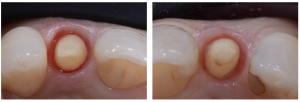Improving smile aesthetics – Dr Gurvinder Bhirth
Featured Products Promotional FeaturesPosted by: Dental Design 3rd February 2019


Dr Gurvinder Bhirth
A female patient was referred to BPI Dental for prosthodontic work (Figure 1). She wished to replace the metal-ceramic crowns on her laterals in order to eliminate the dark lines visible along the gumline and improve the general aesthetics of her smile.

Fig: 1

Fig: 2
Assessment
Upon review of the patient’s history, it was identified that she had previously undergone periodontal and orthodontic treatment. She was a regular attender at her routine dental practice and very motivated to maintain a good standard of oral health in general. Her medical history was unremarkable and she was otherwise fit and healthy.
A full clinical assessment was carried out, including evaluation of the TMJ, muscles of mastication, soft and hard tissues, as well as a comprehensive periodontal examination. The only abnormality identified was gingival recession on both the laterals (Figure 3).

Fig: 3
Treatment plan
The treatment options presented to and discussed with the patient were:
- Replacement metal-ceramic crowns
- All-ceramic crowns
The patient was advised that due to the small size of the laterals and the amount of recession present, metal-ceramic crowns would be highly destructive and therefore were not recommended.
The patient agreed and chose to proceed with all-ceramic, layered zirconia crowns, involving a vertical preparation design. This would mask the discoloured root surface whilst also minimising the amount of preparation required on the teeth.
Soft tissue thickening
A flowable composite was added to the margins of the laterals to bulk up the area in order for the provisional crown to be made from an impression. This thickens the profile of the tooth, strengthening the provisional crown when the bisacyl material is placed into the impression (Figure 4).

Fig: 4
The previous crowns were then removed (Figure 5) and vertical preparations were completed with no horizontal margins (Figure 6). A gingitage procedure was then performed to aid thickening of the soft tissues while the provisional restoration is in situ (Figure 7). This must be completed in a very controlled manner, as it is very easy to cause irreversible damage to the gingival tissue if a problem occurs. In this case, the procedure created some intra-sulcal bleeding, so the provisional restorations were placed and contoured to support the blood to clot and the surrounding soft tissues (Figure 8).

Fig: 5

Fig: 6

Fig: 7

Fig: 8
Restoration
Four weeks later, the soft tissue already looked thicker and healthier (Figures 9 and 10). A double cord retraction technique was used (Figure 11) in order to take a PVS impression and capture accurate details of the sulcus (Figure 12). The dyes were then checked to ensure that optimal, natural-looking aesthetics could be achieved (Figure 13).

Fig: 9

Fig: 10

Fig: 11

Fig 12

Fig: 13
The provisional restorations were removed to reveal healthy soft tissue underneath (Figure 14). At this point the permanent layered zirconia crowns were cemented into place using Fuji Plus (GC) (Figure 15).

Fig: 14

Fig: 15

Fig: 16
Upon review four weeks later, great soft tissue healing was recorded (Figure 16). This was maintained long-term, with the year follow-up photographs demonstrating healthy soft tissue as desired (Figure 17).

Fig: 17
Discussion
The patient was thrilled with the outcome of treatment in this case and she was particularly delighted that the replacement crowns looked like natural teeth.
This case was a clinical and aesthetic success due to the protocols followed. A conventional horizontal preparation would have potentially weakened the teeth and limited their long-term prognosis. The vertical preparation technique is a great option to have in a clinician’s armamentarium, but great care must be taken to gain adequate training and experience before attempting it in practice. In addition, the laboratory support provided must be excellent in such cases to ensure good aesthetic results. For complex cases, or those requiring treatment that may be beyond your clinical scope, referral for all or part of the treatment is often in the best interests of the patient.
For more information on the referral service available from BPI Dental, visit www.bpidental.co.uk, call 0121 427 3210 or email info@bpidental.co.uk
Author bio:
Gurvinder Bhirth qualified in 1997 from the University of Liverpool and completed a MClinDent (Prosthodontics) in 2018 at King’s College London. He currently works at BPI Dental in Birmingham and accepts referrals for a wide range of advanced prosthodontic treatments.
No Comments
No comments yet.
Sorry, the comment form is closed at this time.



